Click above for a high-res gallery of the 2009 Cadillac CTS-V
After decades of decay, Cadillac began a transformation in the waning years of the last century that would allow the brand to compete against modern luxury brands. Decrepit beasts like the late Eldorado and Seville were euthanized and, while the decision to switch mostly to alpha-numeric naming was dubious, Cadillac finally started creating cars that could compete directly with the best from Europe and Japan, and the first generation CTS was one of them.
In spite of this progress, the Germans still had something Cadillac lacked, namely AMG, M and RS models. So Cadillac devised the V-Series, the first of which was the 2004 CTS-V. Just as BMW does with the M3 and M5, Audi with the RS4 and RS6 and Mercedes with innumerable AMGs, the CTS-V had a bigger, more powerful engine; beefier brakes and tires; a suspension to match and an upgraded interior. This, however, is an arms race that has yet to subsie in spite of ever higher fuel prices. With BMW, Mercedes and Audi now offering even more powerful engines, Cadillac has stepped up to the plate with an all-new CTS-V and we had a chance to drive it at the even newer Monticello Motor Club in New York. With a new supercharged LSA engine closely related to the LS9 in the Corvette ZR1, the CTS-V makes some big promises. Read on after the jump to see if it delivers.
After decades of decay, Cadillac began a transformation in the waning years of the last century that would allow the brand to compete against modern luxury brands. Decrepit beasts like the late Eldorado and Seville were euthanized and, while the decision to switch mostly to alpha-numeric naming was dubious, Cadillac finally started creating cars that could compete directly with the best from Europe and Japan, and the first generation CTS was one of them.
In spite of this progress, the Germans still had something Cadillac lacked, namely AMG, M and RS models. So Cadillac devised the V-Series, the first of which was the 2004 CTS-V. Just as BMW does with the M3 and M5, Audi with the RS4 and RS6 and Mercedes with innumerable AMGs, the CTS-V had a bigger, more powerful engine; beefier brakes and tires; a suspension to match and an upgraded interior. This, however, is an arms race that has yet to subsie in spite of ever higher fuel prices. With BMW, Mercedes and Audi now offering even more powerful engines, Cadillac has stepped up to the plate with an all-new CTS-V and we had a chance to drive it at the even newer Monticello Motor Club in New York. With a new supercharged LSA engine closely related to the LS9 in the Corvette ZR1, the CTS-V makes some big promises. Read on after the jump to see if it delivers.
Photos Copyright ©2008 Sam Abuelsamid / Weblogs, Inc.
American automakers started trying to create what they called Euro-sedans way back in the mid-'80s. At the time, they thought a European sedan was nothing more than a de-chromed version of a regular sedan that was stiffly suspended with a little more tire. The result of this thinking was cars like the Chevy Celebrity EuroSport and Pontiac 6000 STE. Needless to say, none of these were competitive with Audi or BMW were offering. Cadillac didn't even try to compete at back then since it was still selling big Fleetwoods and De Villes. Fast forward two decades and GM has well and truly learned how to build cars that can attack the heart of the German sport sedan segment, as the regular 2008 CTS, which has drawn largely rave reviews since its debut last year, has demonstrated.
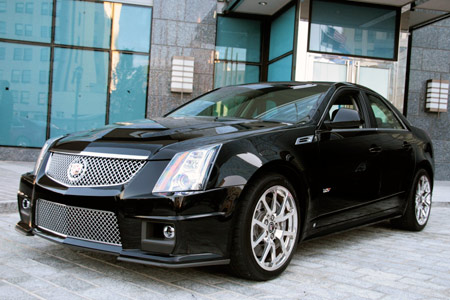
We got a close look at the CTS-V in June at the Milford Proving Ground and went for a ride in one so we already knew the car was fast. With 556 horsepower and 551 lb-ft of torque, how could it not be? But many past GM efforts performed well on the controlled surfaces of a proving ground environment but fell flat on their faces in the real world. So before we hit Monticello, we embarked on a 90-minute route from White Plains, NY that took us through a mix of urban stop-and-go, freeways, small towns and some twisty mountain roads.
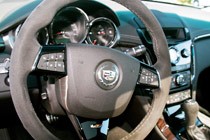
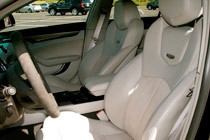
The driving environment of the CTS-V is largely the same as the standard CTS, but with some upgraded trim like micro-fiber inserts in the seats and around steering wheel that feel rich to the touch and look great. The standard seats are based on those in the standard CTS, but unless you have an extra-wide girth, we recommend opting for the 14-way Recaros – you won't be sorry. The standard seats are reasonably supportive and comfortable, but the lower cushions are too short. The Recaros have adjustable thigh supports, as well as adjustable everything else.
The CTS-V does transmit more of the road surface to your back-side than the regular sedan. You will not mistake it for one of those floaty, '80s-era Fleetwoods. Nor is it anything like an early C4 vintage Z51 Corvette. The magnetic ride damping system does a great job of filtering out the unpleasantness while still letting you be aware of what's passing underneath. Similarly, the audible feedback of the tires and exhaust are louder than a base CTS but far less than a typical aftermarket exhaust system. It's a nice balance that lets you know you're driving a serious automobile with very serious sporting pretensions, but that it doesn't mind getting up and going to work each morning.
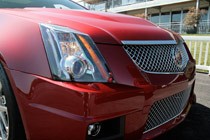
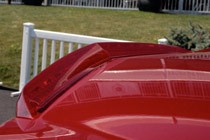
Visually, the CTS-V stands out in a crowd more than either its lesser siblings or its predecessor. The big mesh grille now has twice the open area of the previous V, a necessity to flow enough air for the up to seven heat exchangers. The CTS-V is also the first GM car to be equipped with an electric park brake. The base CTS has one of those old school foot operated jobs, but Cadillac engineers wanted more foot room for the manual transmission CTS-V.
The EPB leaves extra room for the dead pedal on which you can rest your left foot when not using the clutch. With 551 lb-ft of twisting force, the clutch needs a lot clamping force. Fortunately, the use of a dual plate clutch like the one in the ZR1 means that your left leg won't end up being twice the size of your right. The clutch effort is nicely weighted and the travel is well matched to the accelerator and brake.
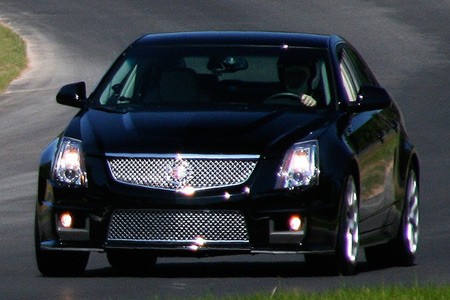
Once we got to Monticello, there was a briefing from CTS-V lead performance integration engineer Chris Berube. Along with all the technical details about the engine, he gave us a warning about shift points. Showing us the power and torque curves, he noted that most engines reach a power peak somewhere below their maximum rpm. Even without looking at the tach, you can feel the loss of acceleration as you approach the red-line. Such is not the case with the LSA power-curve. It has no peak, rather it just ends at the red-line. If the valve-train and other components could withstand higher sustained speeds, it could make even more than its advertised 556 horsepower. Thus, it's very easy to hit the CTS-V's rev-limiter before you know what's happening. The speedometer and tach have red tracer LEDs that follow the needles as they arc around the dial, and as you approach red-line they start to flash.
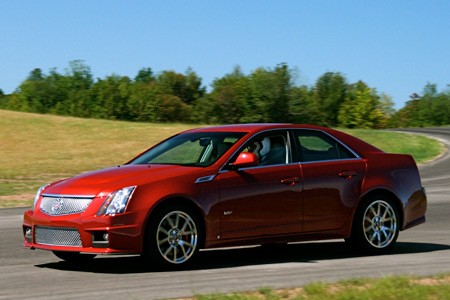
This new Monticello track is absolutely astounding. It's a 4.1-mile, 22-turn natural terrain circuit designed by veteran road racer Brian Redman and track architect Bruce Hawkins. We'll tell you more about the Monticello Motor Club in a separate post later, but suffice it to say that this was a perfect locale for the debut of the CTS-V. It took some getting used to since none of us had seen the track before, especially since it's so long, and with 500 feet of elevation change, there are many different types of turns. It's challenging for drivers of any skill level, especially driving a monster like the CTS-V.
Like the team responsible for the ZR1, the CTS-V crew strove to build a car with immense performance that was at the same time very usable on both the street and track. A driver with less skill can thrash it without getting bitten back at every wrong move. For those with a higher degree of skill, the CTS-V offers a higher ceiling for exploring even greater limits. Switching the stability control system to Competitive mode raises all the thresholds before the system will intervene, which allows you to hang the tail out in a controlled drift before reeling it back in.
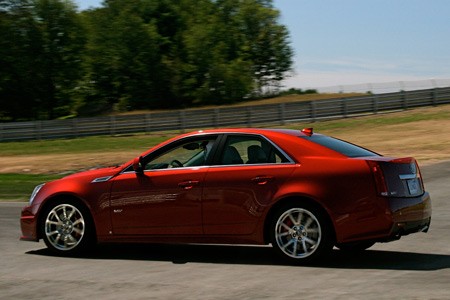
Switching the magnetic ride control from Touring to Sport will noticeably reduce body roll. Sport mode is probably a bit too harsh for use every day, unless you live somewhere with really smooth pavement. Ride quality wasn't an issue on the perfectly contoured pavement of the Monticello track and the stiffer damping allowed the car to respond to our inputs much quicker than in Touring mode.
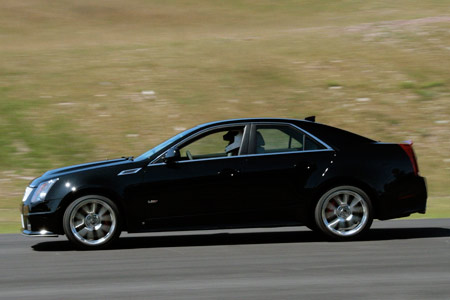
With a mass nearly 900 lbs more than the ZR1 and considerably less Michelin rubber wrapped around its wheels, the CTS-V could never be expected to be as nimble as the two-seat Chevy. However, any car with this much power that can put it to the ground with no hint of wheel hop or axle tramp is clearly doing something right. Cadillac uses an asymmetric half-shaft setup that has different natural frequencies on each side of the rear axle, which prevents the two wheels from getting into a race condition. Combined with the traction control system that uses signals from the stability control to vector the torque and help turn-in, driving the CTS-V extremely fast comes naturally.
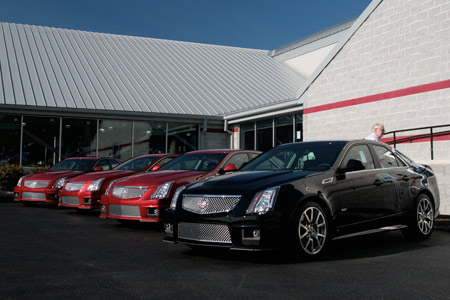
Production of the new CTS-V starts in October and Cadillac hasn't finalized pricing yet. We're told to expect a base price of about $60,000 with only a handful of options, but the only option you really need are those Recaro seats. That's more than $20,000 less than a BMW M5 or a Mercedes-Benz AMG E63 – and the Cadillac is faster than both. For those who crave the supercharged grunt of a ZR1 but regularly need space for more than one passenger, the 2009 CTS-V will get you shockingly close in a remarkably sophisticated package that's a bargain in this segment.
Photos Copyright ©2008 Sam Abuelsamid / Weblogs, Inc.
Our travel and lodging for this media event was provided by the manufacturer.
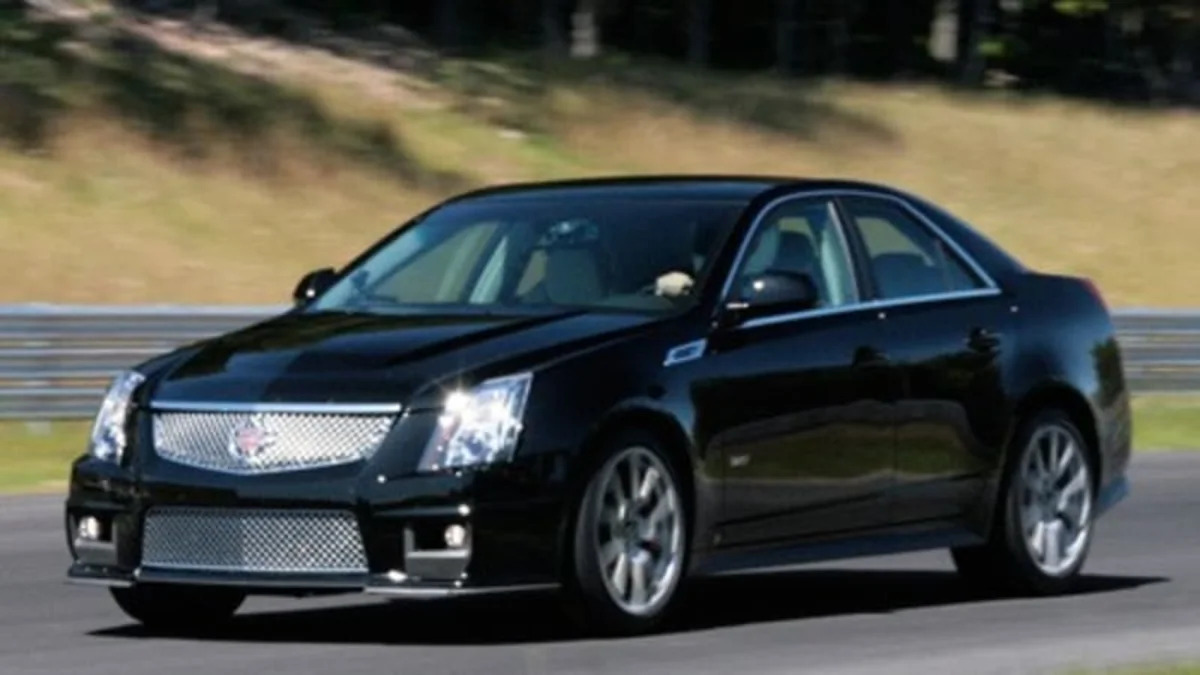


Sign in to post
Please sign in to leave a comment.
Continue